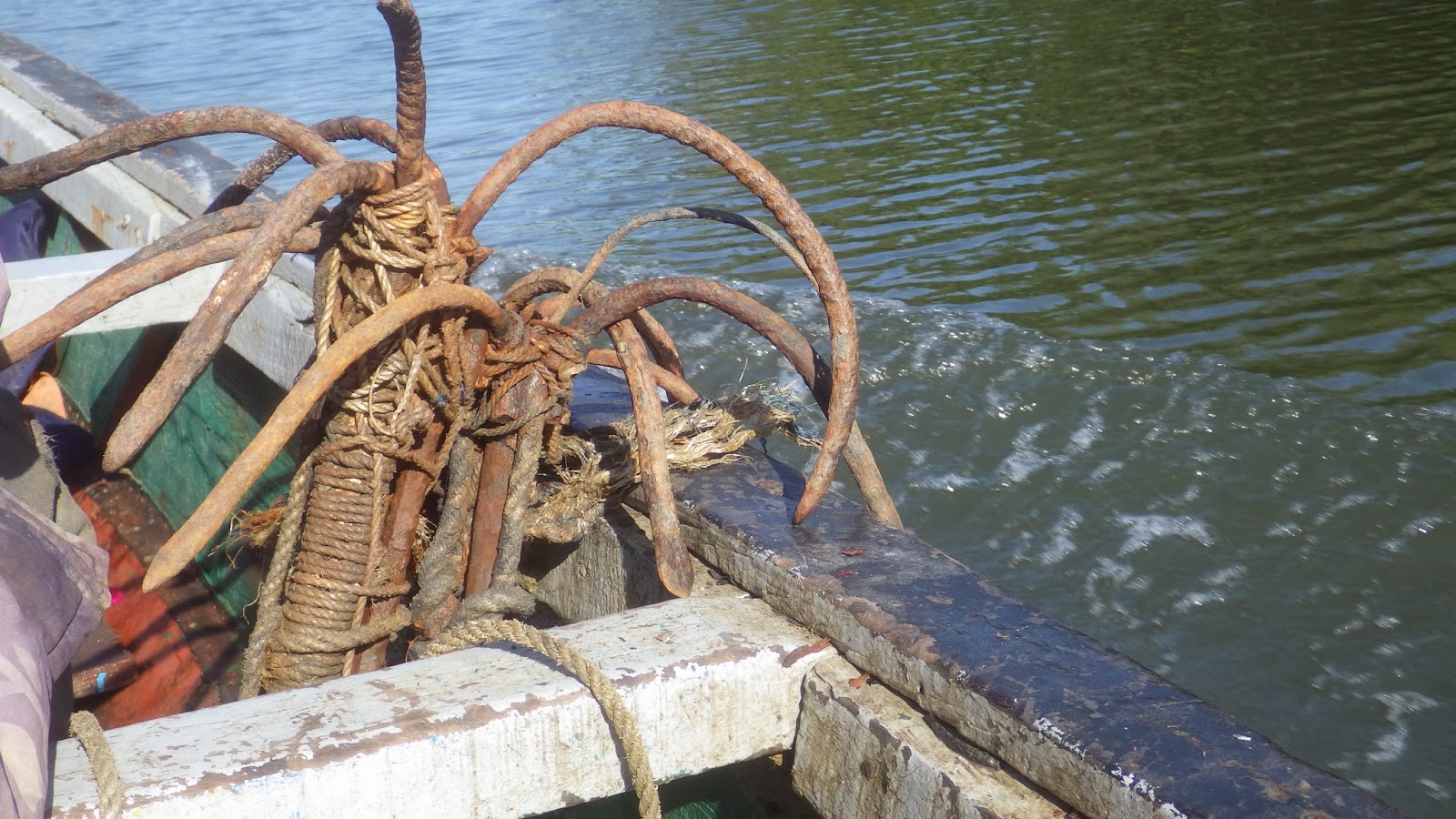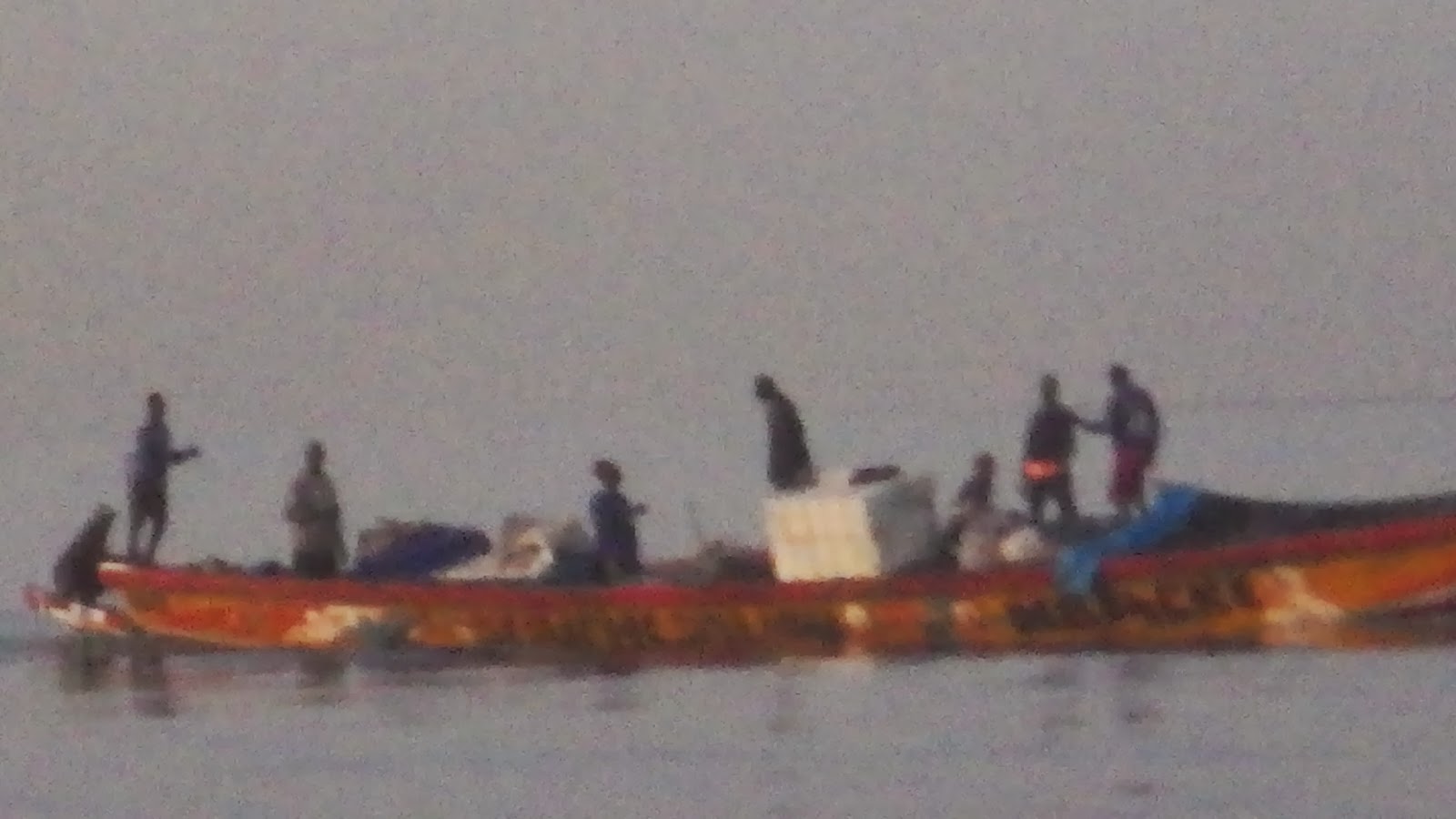 |
| Adele, Zephyr and Looli return from a Senegalese village |
First came floating islands of sargassum weed. Next
the rocky islands of the Atlantic. But finally in Senegal, then Gambia, the
crew of “Moon River” stepped out onto a continent for the first time since we
left New York last June.
By sailing to Africa from Cape Verde – with Halloween at sea
– we added a strange protrusion from the otherwise circular path of our
Sargasso circumnavigation.
Yet, continent or not, it seemed throughout our time in
Africa that we were still barely more on land than afloat.
This wasn’t a trip to that Africa of savanna or mountains. There were no elephants or lions. This was a sojourn in the watery version of Africa, an
Africa so impermanent, so vague, that land and water mix, literally, in a muddy
expanse starting miles out to sea and narrowing into rivers that snake far
beyond the coasts.
Few foreign sailors get to Senegal and The Gambia, and on
arriving in a sailing yacht you can find yourself greeted as if you’d landed in
a UFO. To most locals your boat not only represents unimaginable technical sophistication
and wealth, but something even more incomprehensible: freedom.
 |
| "Moon River" in the Casamance River |
African sailors of all stripes found “Moon River” a mystery,
a sort of fragile toy, a luxurious caprice, and at the same time a machine
for the kind of sea voyages they could not -- would not -- begin to contemplate. They were
always amazed to hear we’d sailed from America, that we sometimes spent weeks
on the open sea, and were preparing to sail on from Africa back across the
Atlantic. At times they didn’t believe us.
In these waters, the only boat really at home is the
pirogue. These come in different sizes but almost always the same banana shape.
Some are the hollowed trunks of trees; others are constructed with planks. Some
are left their natural wood color; others (most) are brightly painted and
emblazoned with names like “Sante Yalla,” “Still Fire,” “Gamme Yalla,” “Koufa
Yakour.” I saw one whose name was “In Jesus Name.”
Pirogues have paddles, not oars, which were considered a major technological advance in ancient times, but are not used
in West Africa. Some have outboard engines.
And they all leak. In every pirogue someone is bailing
water.
Pirogue fishermen occupy just about the poorest economic rung and one whom
we met in Senegal’s Casamance River was so poor that even his bucket had holes.
We gave him one of ours. We also gave him a little material to caulk the worst
of his leaks.
 |
| pirogue anchors |
But the pirogue fishermen we saw everywhere – from the
industrial harbor in Dakar to the furthest corner in the Casamance –didn’t let
things like leaks get in their way.
Small pirogues with one or two men aboard sailed through
creeks and rivers that don’t even appear on charts (not that they have charts.)
 |
| Senegalese fishermen Sherif and Zal |
 |
| they caught a barracuda in a net |
Big pirogues carrying crews of a dozen men and boys go 10 or 15 miles
out into the Atlantic, where the seabed is still only a few meters down through
murky water, and fish remain plentiful. At dawn, they return to their river
harbors, roaring in, the crews in rags, but often strikingly proud looking,
nonchalant, supremely comfortable aboard. They might as well have be coming
directly from the set of a pirate film.
 |
| Hand building new pirogues in Dakar |
Margins are thin and the risks enormous.
Once we gave a tow to two fishermen who had set themselves
the task of paddling 14 miles upriver to market on a savagely hot afternoon.
They had big fish in an icebox, but the ice was almost gone. I suppose if we
hadn’t shown up, they simply would have kept paddling, and arrived with
worthless fish.
Accident – good or bad – is the constant companion on these
edges of the maritime world.
Some would call that fate, but the pirogue men do little to
challenge their fate. They go with the flow, so to speak. They do things the
way they’ve always been done. They keep bailing water. And paddling.
At night, sailing off the coast of Gambia, we found
ourselves caught in a galaxy of pirogues, literally becoming trapped in the
fleet and unable to turn one way or another without risking a new collision.
The pirogues hadn’t been out there as we sailed through dusk.
So I don’t know how they all materialized miles offshore in the dark. But
they did and then they were invisible, except for crazy assortments of lights waved
in an effort to warn us away.
Normally, boats at night show internationally recognized combinations
of colored lights. With these, you can signal your direction, your size, even the
nature of your business. These codes are crucial to enabling boats to avoid
each other.
But among the pirogues, the chaotic mixture of bicycle
lights, torches, and sometimes even charcoal braziers, filled the ocean with incoherent
flashes, beams, and flickers, forcing us to steer “Moon River” in zigzags,
always trying to escape into clearer waters, but usually straying into yet
another group of pirogues.
At best, a collision meant us becoming entangled in a net,
ruining their fishing and perhaps crippling our steering gear. A direct hit
could easily sink a pirogue and probably “Moon River,” and possibly kill a
fisherman.
What could we do? What could they do?
 |
| big pirogue returns to Dakar at dawn |
Then incredibly, mysteriously, when the sun finally rose we found
ourselves alone again. There was not a pirogue in sight.
We arrived in Banjul, the capital of The Gambia, as the sun
rose red in a sky filled with Saharan sand. Now we were on the continent. Yet for me, we’d already been in deepest Africa.
We’d been
there all night.




Wow! Africa all as strange and unreal to us as your visit must have seemed to the Senegalese fishermen themselves. Read Adèle's piece in AFP blog, and that was scary stuff. Thanks Seb. Try to keep the blog going this time!!!! Jeremy and Fiona
ReplyDeleteImpressive passage and writing. Thank you. I found it via its referencing on Pirogue Wikipedia. Please can you help with a estimate of offshore Pirouge crusing speed under power please. Some are being lost with failed motors and finding there possible positions wants this approximate value please
ReplyDelete